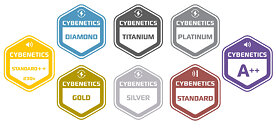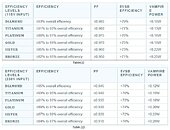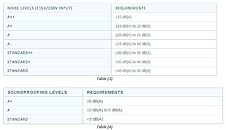Wednesday, December 30th 2020
Cybenetics Introduces Easy PSU Efficiency and Noise Badges
Cybenetics, the company behind the Cybenetics power supply rating system, introduced a new certification badge system that makes it a lot easier to gauge the efficiency and noise of a PC power supply unit when making a purchase decision. Unlike competing PSU certification services, Cybenetics doesn't just use brute 12 V switching efficiency to gauge the quality of a PSU, but takes into account the efficiency of the individual voltage domains, power-factor correction, vampire power (losses), etc., to present a more complete measure of a PSU's efficiency. Cybenetics also offers a logo program to gauge the noise output of a PSU, so you know a PSU isn't cutting corners with noise in pursuit of switching efficiency, and has sufficient heatsink mass to afford a quieter fan.
Cybenetics Efficiency logo grades resemble precious metals and gems, much like sports medals. It begins with "Standard," and goes through "Bronze," "Silver," "Gold," "Platinum," "Titanium," and "Diamond." The first table below shows what it takes to qualify for each of these. It's important to note that the grading system takes input AC voltage into account (110~120 V or 220~240 V AC), and there are different parameters for each input voltage type. For PSUs that support both 110 V and 220 V AC inputs (automatic switching), it's likely that it comes with two efficiency logos. Noise output is a more universal rating, and depends entirely on how quiet the PSU is. Since its inception, Cybenetics tested and certified over 770 PSU models, and is testing many more.
Cybenetics Efficiency logo grades resemble precious metals and gems, much like sports medals. It begins with "Standard," and goes through "Bronze," "Silver," "Gold," "Platinum," "Titanium," and "Diamond." The first table below shows what it takes to qualify for each of these. It's important to note that the grading system takes input AC voltage into account (110~120 V or 220~240 V AC), and there are different parameters for each input voltage type. For PSUs that support both 110 V and 220 V AC inputs (automatic switching), it's likely that it comes with two efficiency logos. Noise output is a more universal rating, and depends entirely on how quiet the PSU is. Since its inception, Cybenetics tested and certified over 770 PSU models, and is testing many more.



28 Comments on Cybenetics Introduces Easy PSU Efficiency and Noise Badges
Standard looks like Bronze, Standard ++ looks more Gold than the Gold rating badge itself.
Just looking at them tells me almost nothing without having to remember a bunch of random defined attributes.
Not to mention that the scale is at least for me, not intuitive. Platinum is a far more expensive element than diamond and I would never think diamond would place higher on the list because of it. Except if you assume that they mean brilliant diamonds, proper excellent cut jewels. But I don't, at least not per default. I think of the cheapo industrial ones im used to using.
Whats so wrong with just slapping a sticker on a PSU that states the overall efficiency and noise directly? "87-89% overall efficiency, 15-20 dB(A)" Nice and easy, quick to read, easy to compare, no wasted space or work in doing a fancy sticker.
But then again, these things are never about making it easy to pick and choose, its about making it sound as fancy as possible to sell more crap.
Besides, it USED to be that most 80+ Gold units were something you could unreservedly recommend, but nowadays it's by no means a guarantee of a good unit.
Basically anything below gold and A you would need to have a good reason to buy (e.g. strict budget, office PC etc.).
Just pass, the lowest tier:
+5V Regulation: ±5% Ripple: 50mV
+12V Regulation: ±5% Ripple: 120mV
+3.3V Regulation: ±5% Ripple: 50mV
Tier 4:
+5V Regulation: ±3% Ripple: 30mV
+12V Regulation: ±3% Ripple: 60mV
+3.3V Regulation: ±3% Ripple: 30mV
Tier 3:
+5V Regulation: ±2% Ripple: 20mV
+12V Regulation: ±2% Ripple: 30mV
+3.3V Regulation: ±2% Ripple: 20mV
Tier 2:
+5V Regulation: ±1% Ripple: 10mV
+12V Regulation: ±1% Ripple: 15mV
+3.3V Regulation: ±1% Ripple: 10mV
Tier 1:
+5V Regulation: ±0.5% Ripple: 5mV
+12V Regulation: ±0.5% Ripple: 10mV
+3.3V Regulation: ±0.5% Ripple: 5mV
Ofcourse, these are not the all specs needed to define PSU DC quality, but more charecteristics could lead to confusion
:peace:= Platinum
:clap:= Diamond
:rockout:= Gold
:roll:= Silver
:laugh: = Bronze
:kookoo: = Risktaker
www.techpowerup.com/275155/80-plus-hikes-its-testing-and-licensing-fees-could-affect-prices-of-low-volume-psu-modelsWhen is gonna TPU get it fixed that forum emojis can be shown in news replies? :)
Its a improvement to the 80+ system sure, but even then it makes it rather pointless if one has to look up reviews as well. I do that either way but then it kinda loses the whole idea behind it, doesn't it?
The table they show in the picture for example. If they were to just smack that on the side of the box and highlight the result relevant to that product, that would be way easier. You get a easy overview of how that specific product fared in the tests conducted on it. Otherwise one would have to reference such a table almost all the time either way.
For noise seven levels, starting from Standard up to A++ (Standard, Standard+, Standard++, A-, A+, A+, A++)
For chassis soundproofing, there are only three levels: Standard, A, and A+
Cybenetics provides a FULL report including part analysis, cable length, detailed results at high temperatures, ripple, hold-up time, etc for both 115V and 230V in most units, And these tests are conducted by pros using calibrated equipment. Anyone can read the report and decide whether the product meets its demands or not.
Cybenetics is not another review site but a certification agency. For more details and for an opinion, YES you need to read reviews :)
I'll act like the stupid customer now okay?
Yellow badge gives you a 230V audio device it seems, just like A++. They're both ++ though, so obviously, a non-++ rated device is something that looks like a WIFI signal banging up against a wall.
Diamonds are teal now, Titanium is dark grey and Platinum is obviously a darker silver :oops:.
Bronze has gone the way of the dodo, so you can forget any meaningful relative idea to 80+ certifications. Basically, if you're not reading the full spec behind each badge, they might as well be selling fridges, TV's or Cyborgs.
Oh by the way, ALL badges that are not audio devices or problematic wifi signalling, are perpetuum mobile devices, as the logo shows for Platinum etc. below. They apparently also recycle themselves.
Where can I sign up?
This is tried and tested by many many food companies. We have tons of certifications for healthy food, but we don't eat healthier for it. The stickers do still help to draw customers to whatever is easiest and cheapest to market. Supermarkets are STILL selling far too much sugar and the same cert. stickers are on less healthy alternatives than just untreated food. We know this. Cybenetics knows this. Commerce knows this. Let's not play dumb.
You nailed it with your last sentence. People need to read reviews. If you believe so many badges are useful, you can't possibly believe customers will understand all of them. Its a paradox.
You know what helps? Videos showing PSUs that blow up or give excessive ripple at normal loads. Naming and shaming. Its fun to watch and not another layer of meaningless complexity.
Also the editor might want to revise this:"Standard" is not about efficiency, it's about noise. Efficiency begins with "Bronze".
Imho, 80Plus did it right first: it told you you were getting 80% efficiency no matter what. It went downhill from there. But tbh, when you want to look at more than one parameter, it's pretty much impossible to convey the result using a simple badge.